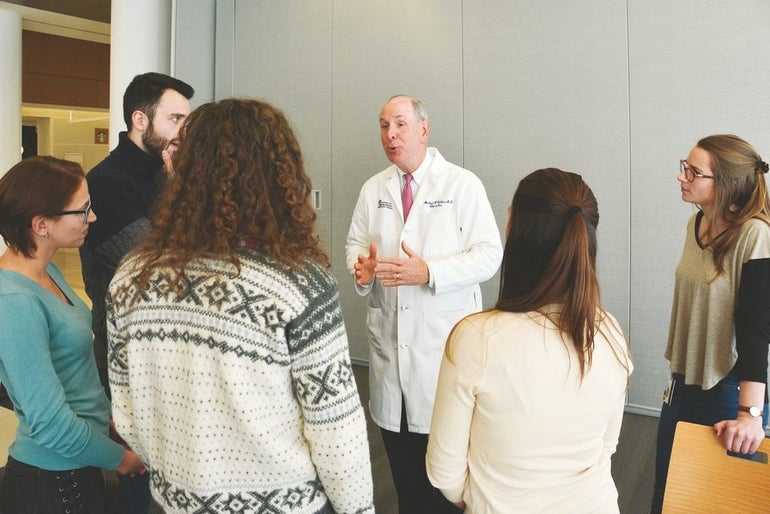When the University of Massachusetts Medical School was chartered in the 1960s, Worcester, Boston, and Springfield all lobbied to bring the school within their respective city limits. Worcester eventually won the bid, but now, more than 50 years later, the medical school is making its way to Springfield.
The state’s Worcester-based public medical school late last year celebrated the launch of its first ever regional campus, in a partnership with Baystate Health and UMass Amherst. Starting this year, UMass Medical School will admit 25 students into its new population-based urban and rural community health (PURCH) track, which emphasizes urban and rural medicine and population health management.
The idea is to teach students how to work to manage the overall health of underserved communities, and to hopefully fuel the pipeline of doctors going to work out west, where there is a need for well-trained primary care physicians and specialists, according to the medical school.
“What we’re hoping is the students will come as first-year students and learn the clinical aspects of medicine here, so maybe they’ll want to train here, and if they want to train here, they’ll practice here,” said UMass Medical School Chancellor Michael Collins.
UMass Medical’s first physical expansion comes shortly after it widened its student base to make room for out-of-state students and about a year and a half after an academic affiliation with Cape Cod Healthcare was announced. This all just part of Collins’ larger plan to make UMass Medical School “the Stanford of the Northeast,” as he put it, and to grow the number of qualified doctors in Massachusetts. Currently, 62 percent of UMass Medical School graduates go on to practice in-state.
“We’ll be training a cohort of students with consistent clinical experiences to manage a population of patients throughout their clinical training,” said Collins.
Changing healthcare landscape
Today’s dynamic healthcare environment places a strong emphasis on improving the overall health of a population – on value rather than on volume. The PURCH program, and the overall medical education UMass Medical School now offers, are taught with that in mind, Collins said.
Medical schools across the country are in various stages of implementing the accountable care model into their curriculums, said Scott Shipman, director of primary care initiatives and workforce analysis at the Association of American Medical Colleges (AAMC).
If medical schools want to prepare their students for careers as doctors in the 21st century, it’s important that they emphasize team-based care, Shipman said. A good healthcare team not only means everyone is working to their full potential, but it also means thinking outside the box and adding appropriate specialists, like pharmacists and social workers.
Medical students also need to be trained in environments where specialists and primary care doctors communicate effectively with each other, and in places where social determinants of health – such as housing and economic status – are taken into account by providers.
These ideas are implemented to varying degrees in medical schools throughout the United States, Shipman said.
“There’s a widespread and growing recognition that changes in the way health care is being financed and the consequent changes in how health care is being delivered needs to translate into how the next generation of providers have trained,” he said.
UMass Medical is teaching its students to work in team-based environments, Collins said.
Western Mass impact
Andy Artenstein, regional executive dean of UMass Medical School-Baystate and chief academic officer at Baystate Health, said partnering with the Worcester-based medical school made perfect sense for the Springfield-based healthcare network, which until last year had Tufts University School of Medicine as its primary academic affiliation.
“There are quite a few similarities in terms of patients and the challenges the [two] communities face,” he said.
Students will undergo the same curriculum as Worcester-based UMass Medical School students. They will take classes in Worcester and undergo clinical training in Springfield. In their last two years, they will work in the hospital and in outpatient settings, where they will see patients regularly, said Artenstein.
PURCH is based around the idea of training people for careers as primary care physicians, because of a national doctor shortage that disproportionately affects more isolated areas like Western Massachusetts. The AAMC predicts a shortage of between 14,900 and 35,600 primary care physicians by 2025. However, students will be encouraged to branch out into whatever area of medicine they’re interested in, even if it’s not primary care, said Artenstein.
“Some of them may go on to be surgeons, and that’s all good. The commonwealth needs those people too,” he said.
Physician need is especially great in Western Massachusetts, where it isn’t as easy to recruit physicians as it might be in say, Boston, said Kevin O’Callaghan, president of the Hampden District Medical Society, one of 20 district societies that makes up the Massachusetts Medical Society.
“If people aren’t from here and they don’t train here, they don’t know what’s here,” he said. “They don’t know the kind of career they can have here. The larger urban centers have more resources to put towards that sort of marketing of their career tracks, but often they don’t have to.
“Having a dedicated training program in our community allows us to show people how effective they can be as physicians in our community, and what a great need there is for dedicated, active advocates,” he said.
O’Callaghan, who is also employed by Baystate Health, said physicians outside of the Baystate umbrella also want to be part of the education of the PURCH students. Many doctors in Western Massachusetts either work alone or with two or three other practicing physicians, which is an entirely different experience than being employed by a larger network, he said.
“Many aspects of being in a small practice more akin to being a small business owner than a physician,” he said. “We hope the partnership will incorporate the perspective of those providers.”

